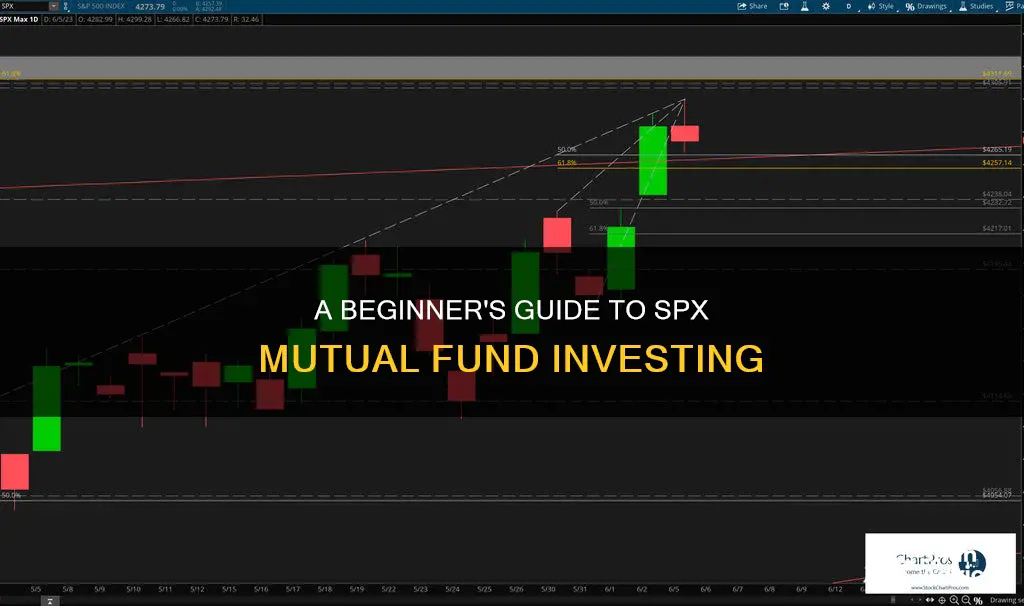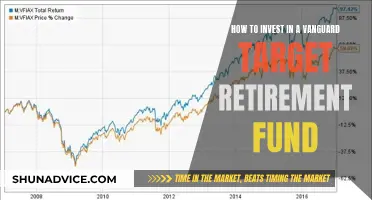
The S&P 500 index is a stock market index that measures the performance of the top 500 American companies on the stock market. An S&P 500 index fund is a type of mutual fund that buys stock in the companies on the S&P 500 index.
Index funds are a passive form of investing. They are not actively managed by a fund manager but are designed to mirror the performance of the index.
You can buy an S&P 500 index fund or exchange-traded fund (ETF) through a taxable brokerage account, a 401(k), or an IRA.
1. Find your S&P 500 index fund: Compare funds based on their expense ratios and sales load.
2. Go to your investing account or open a new one: Access your existing investing account or open a new one, such as a 401(k), an IRA, or a regular taxable brokerage account.
3. Determine how much you can afford to invest: Figure out how much you can invest and regularly add money to the account.
4. Buy the index fund: Go to your broker's website and set up the trade by inputting the fund's ticker symbol and the number of shares you want to buy.
Some popular S&P 500 index funds include:
- Vanguard S&P 500 ETF (VOO)
- SPDR S&P 500 ETF Trust (SPY)
- iShares Core S&P 500 ETF (IVV)
- Schwab S&P 500 Index Fund (SWPPX)
| Characteristics | Values |
|---|---|
| Type of fund | Mutual fund or exchange-traded fund (ETF) |
| Investment strategy | Passive index replication |
| Investment scope | 500 leading U.S. companies |
| Investment sectors | Information Technology, Financials, Healthcare |
| Top 10 constituents | Microsoft, Amazon, Alphabet, Meta, Berkshire Hathaway, Eli Lilly, Broadcom |
| Expense ratio | 0.03% to 0.16% |
| Minimum investment | $0 to $3,000 |
| Brokerage account | Taxable brokerage account, 401(k), IRA |
What You'll Learn

What is the S&P 500?
The Standard and Poor's 500, or S&P 500, is a stock market index that tracks the stock performance of around 500 of the largest companies listed on US stock exchanges. It is one of the most widely followed equity indices, representing approximately 80% of the total market capitalization of US public companies.
The S&P 500 is often regarded as a bellwether for the American stock market and the broader economy. It includes stocks across all 11 sectors of the economy, as defined by the GICS classification system. The index is weighted according to the size of the companies, with larger companies carrying more weight. The price of the S&P 500 index is measured in points and is calculated based on the market capitalization of each company within the index.
The S&P 500 has a long track record of strong performance, returning about 10% annually on average over the long term. This has made it a popular investment choice, with tens of trillions of dollars invested in the companies that make up the index.
While it is not possible to invest directly in the S&P 500 itself, investors can gain exposure to the index by purchasing individual stocks of companies within the index or by investing in an S&P 500 index fund or exchange-traded fund (ETF). Index funds and ETFs aim to replicate the returns of the S&P 500 by tracking its performance, offering investors a diversified portfolio with instant access to a wide range of companies.
Convince Your Family to Invest in Hedge Funds
You may want to see also

How to invest in an S&P 500 index fund
The S&P 500 index is a stock market index that measures the performance of the top 500 American companies on the stock market, representing approximately 80% of the available U.S. market capitalization. An S&P 500 index fund is a type of mutual fund or exchange-traded fund (ETF) that tracks the performance of the S&P 500.
- Understand the S&P 500 Index and Index Funds: The S&P 500 index is a collection of the top 500 U.S. companies based on factors such as market capitalization, sector allocation, and liquidity. An index fund is a type of investment fund that is based on a preset basket of stocks or an index. S&P 500 index funds aim to replicate the performance of the S&P 500, providing investors with exposure to a diverse range of large U.S. companies.
- Research and Analyze Index Funds: When choosing an S&P 500 index fund, consider factors such as geographic location, business sector, and market opportunity. Compare different funds to find one that aligns with your investment goals and has a strong long-term performance track record. Also, look into expenses, taxes, and investment minimums to make an informed decision.
- Decide on a Brokerage Account: You can purchase S&P 500 index funds through a brokerage account. If you don't already have one, you'll need to open an account with a broker that offers the fund you want to invest in. Consider factors such as fees, investment options, and ease of use when choosing a brokerage.
- Determine Your Investment Amount: Figure out how much you can afford to invest. You can add money regularly to your brokerage account and aim to hold it for at least three to five years to give your investments time to grow.
- Buy the S&P 500 Index Fund: Once you've selected a fund and determined your investment amount, go to your broker's website and place the trade. You can set up recurring purchases to take advantage of dollar-cost averaging and reduce risk.
Remember that investing in the S&P 500 comes with certain risks, including stock market volatility and the inherent risks of equity investing. It's important to do your own research and consult with a financial advisor before making any investment decisions.
Index Fund Investing: TD Ameritrade Guide
You may want to see also

Advantages and disadvantages of investing in the S&P 500
Advantages of Investing in the S&P 500
The S&P 500 is one of the most renowned stock market indices globally, and it offers exposure to a broad range of leading companies across various industries. Here are some advantages of investing in the S&P 500:
- Diversification: The S&P 500 provides instant diversification by encompassing 500 large-cap U.S. stocks from various sectors, reducing the risk associated with investing in individual stocks. It offers exposure to industries like technology, healthcare, finance, and consumer goods.
- Long-Term Growth: Historically, the S&P 500 has shown strong long-term growth potential, consistently outperforming many other investment options. While short-term market fluctuations may occur, the underlying trend has been upward due to the growth of the U.S. economy.
- Accessibility: The S&P 500 is accessible to a wide range of investors through index funds, exchange-traded funds (ETFs), or mutual funds, making it suitable for both individual investors and those with limited investment knowledge. Many brokerage platforms also offer low-cost options.
- Professional Management: The S&P 500 is managed by a committee that ensures the index accurately represents the U.S. large-cap stock market. This committee regularly reviews and adjusts the index constituents, providing investors with confidence in the index's composition.
Disadvantages of Investing in the S&P 500
While the S&P 500 has its advantages, there are also some potential drawbacks to consider:
- Market Volatility: Although the S&P 500 has historically shown long-term growth, it is not immune to market volatility and downturns, which can result in significant declines in index value. Investors need to have a long-term investment horizon and be able to weather short-term fluctuations.
- Lack of Individual Stock Selection: Investing in the S&P 500 means investors relinquish control over individual stock selection, potentially missing out on gains from stocks that outperform the broader market. Some investors may prefer a strategy that includes individual stock selection for more control over their portfolio.
- Concentration in U.S. Stocks: The S&P 500 is heavily weighted towards U.S.-based companies, which may result in a lack of exposure to international markets and limit the diversification benefits that could be gained from global investments.
- Inclusion of Underperforming Stocks: While the S&P 500 committee periodically reviews the index constituents, there may be instances where underperforming stocks remain in the index for a certain period, impacting overall performance.
Debt Funds on Zerodha: A Step-by-Step Investment Guide
You may want to see also

How much does it cost to invest in the S&P 500?
The S&P 500 is an index composed of 500 leading U.S. companies, and it powers some popular index funds. The easiest way to invest in the S&P 500 is through an index fund or an exchange-traded fund (ETF) that tracks the index.
If you are investing in an S&P 500 index fund:
- If your index fund has no minimum, you can usually purchase any dollar amount. If your index fund has a minimum, then you have to purchase at least the minimum amount.
- If your index fund has an expense ratio, you'll be charged that as a fee. An expense ratio is an annual fee expressed as a percentage of your investment. For example, if you invest $100, and your fund has an expense ratio of 0.04%, you'll pay an annual fee of $0.04. Some of the biggest and most popular S&P 500 index funds charge less than 0.10% annually.
- Some S&P 500 index funds have minimum investments of $3,000.
If you are investing in an S&P 500 ETF:
- ETFs trade similarly to stocks and have a share price. Depending on your broker, you will either need to pay the full share price or you can buy fractional shares for any dollar amount.
- ETFs often have expense ratios, so make sure you are aware of the fees.
If you are investing in a stock within the S&P 500 index:
Stock costs vary significantly. Some stocks in the S&P 500 cost under $100, and others cost $500 a share or more.
The difference in fees between S&P 500 index funds and ETFs is marginal. For example, Vanguard's S&P 500 ETF (VOO) has an expense ratio of 0.03%, while the Vanguard 500 Index Fund Admiral Shares (VFIAX) has an expense ratio of 0.04%.
SBI Multicap Fund: A Comprehensive Guide to Investing
You may want to see also

How to choose an S&P 500 index fund
S&P 500 index funds are a popular investment choice, as they are based on an index composed of 500 leading U.S. companies. Here are some key considerations to help you choose the right S&P 500 index fund for your investment portfolio:
- Expense Ratio: This is the annual fee charged by the fund manager, expressed as a percentage of your investment. Look for funds with low expense ratios, as this will maximize your returns.
- Sales Load: This is a sales commission charged by some mutual funds. It is best to avoid funds with a sales load, as these extra costs can eat into your investment returns. ETFs do not typically charge a sales load.
- Minimum Investment: Some funds require a minimum investment amount. Make sure the fund you choose aligns with the amount you have available to invest.
- Dividend Yield: Compare the dividend yields offered by different funds, as this can boost your returns even in down markets.
- Inception Date: If you prefer a fund with a proven track record, consider choosing one with an earlier inception date. This will allow you to evaluate its performance over a longer period, including how it has navigated bull and bear markets.
- Account Type: Consider whether you want to invest through a taxable brokerage account, an IRA, or a 401(k). Different funds may be better suited to different account types.
- Brokerage Platform: Choose a brokerage platform that offers a wide range of ETFs and mutual funds without trading fees. This will give you access to a larger pool of funds to choose from.
Remember, the key to choosing an S&P 500 index fund is to focus on minimizing fees and ensuring the fund aligns with your investment goals and budget. By selecting a fund with low costs and an appropriate minimum investment, you can maximize your returns and build a strong investment portfolio.
Best Vanguard Funds for Your IRA: Top Picks
You may want to see also
Frequently asked questions
The S&P 500 is a stock market index composed of about 500 large public U.S. companies. It is often considered a proxy for the overall health of the U.S. stock market.
You can't invest directly in the S&P 500, but you can buy individual stocks of companies in the index, or invest in an S&P 500 index fund or ETF. Index funds are typically less risky than individual stocks.
Investing in the S&P 500 can instantly diversify your portfolio. It gives you exposure to some of the biggest companies in the U.S. across a range of industries and sectors.
The S&P 500 consists only of large-cap U.S. stocks, so it doesn't offer the same level of diversification as a portfolio that includes mid- and small-cap companies, international companies, and other asset classes.







